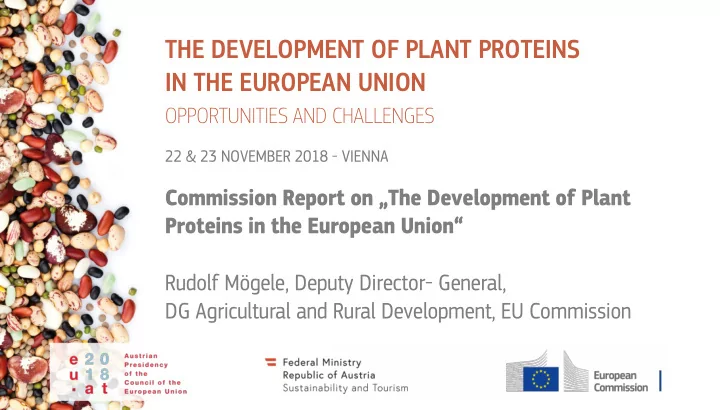

THE DEVELOPMENT OF PLANT PROTEINS IN THE EUROPEAN UNION OPPORTUNITIES AND CHALLENGES 22 & 23 NOVEMBER 2018 - VIENNA Commission Report on „The Development of Plant Proteins in the European Union“ Rudolf Mögele, Deputy Director- General, DG Agricultural and Rural Development, EU Commission
Recalling the work programme on the protein report Externally contracted m arket study 4 Expert w orkshops ”Research and innovation" in Brussels Stakeholder survey Com m ission ”Environm ent and agronom ic practices" in Rom ania w ith 4 4 4 replies from report on plant ”Supply chains" in France experts proteins in the EU ”Market segm ents" in The Netherlands Bilateral m eetings w ith Mem ber States and Stakeholders
EU use of protein and their sources (in million tonnes of crude proteins 2016/17)
Area shares for protein crops in the EU
Three main market segments for plant proteins Conventional Prem ium com pound Food feed feed
Conventional Compound Feed By far the largest outlet for plant proteins • (more than 75%) Growth rates for compound feed • will slow down, to 0,3% per year until 2030 Higher growth rates for animal • products in Eastern Europe Most dynamic sectors are feed for • poultry and dairy Market mainly price driven • Limited prospects for EU-grown protein crops •
Premium Feed Share of non-GM feed is growing dynamically • (2012 11% in EU, in 2018 ?) Also substantial growth rates in organic production of animal products, • on average 10% Shares of organic dairy production surpass 10% in some Member States • Main features : growing demand for sustainably produced animal • products, labelling new regional supply chains but also possibility to use of existing supply chains, sourcing issues/year-round availability not ensured
Premium feed: the example of Austria Case study: Situation estimated for 2018 for • feed used in different animal sectors Austria among top users of • premium feed Will other Member States • follow a similar trend?
Food segment Small market with promising prospects: e.g. dairy and meat alternatives • 11% and 14% per year Pulse-rich diets become more • popular through changing diets (in some Member States) The different outlets still status • of niche markets Interest of major food companies • and retailers Trend driven by flexitarians • High profit margins but need to further build supply chains •
Agronomic, environmental and climate benefits of legumes Benefits : Challenges : • Fertilising effect in crop rotation • Yield variability and yield gaps • Increase yields of following crops • Relatively demanding on agronomic • Improve soil condition practices (pest and weed control) • Break pest cycles • Low agronomic expertise • Positive effects on biodiversity • Environmental benefits not automatic
Policy instruments and initiatives today Main CAP instruments supporting protein plants: • Greening: 27 Member States allow legumes on EFA area Rural development programmes with AECM VCS: 16 Member States use VCS in 2019 • Research : EIP-AGRI (14 programmes) & Horizon2020 (4 programmes) In addition Member State initiatives , e.g. • national plans in Germany, France and Poland National Policy initiatives closely linked to protein, e.g. • Dutch Food Policy and Danish National Bioeconomy Panel European Soya Declaration •
Conclusions Main drivers for future development of EU-grown plant proteins: Relative competitiveness versus other crops and non-EU plant proteins • Supply chain development and producer organisations • Recognition of legume’s contribution to environmental and climate targets • Evolving consumer behaviour and preferences • Influence of other policies and debates in society (deforestation, SDGs, • Renewable Energy Directive, European Bioeconomy Strategy)
Way forward Five options for further action : Use opportunities in proposed future CAP: support • Member States in integrating them in strategic plans Continue to boost competitiveness through • Research and Innovation Improve market analysis and transparency • Promote benefits of plant protein for nutrition, • climate and environment Increase sharing of knowledge/best practice •
Recommend
More recommend